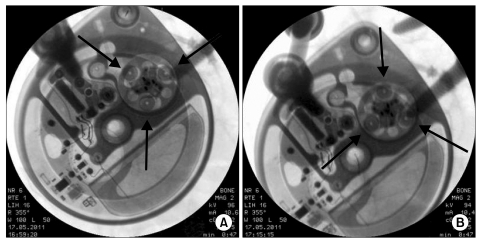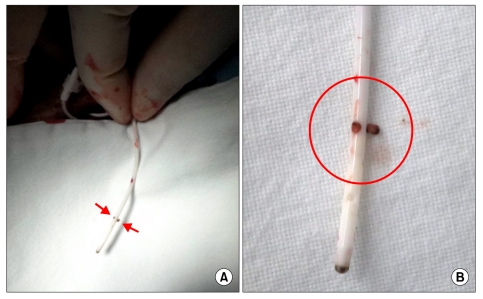Korean J Pain.
2012 Jan;25(1):47-51. 10.3344/kjp.2012.25.1.47.
Catheter Obstruction of Intrathecal Drug Administration System: A Case Report
- Affiliations
-
- 1Department of Anesthesiology and Pain Medicine, Seoul National University Bundang Hospital, Seongnam, Korea. hiitsme@snubh.org
- KMID: 2278116
- DOI: http://doi.org/10.3344/kjp.2012.25.1.47
Abstract
- Intrathecal drug administration system (ITDAS) can reduce the side effects while increasing the effectiveness of opioids compared to systemic opioid administration. Therefore, the use of ITDAS has increased in the management of cancer pain and chronic intractable pain. Catheter obstruction is a serious complication of ITDAS. Here, we present a case of catheter obstruction by a mass formed at the side hole and in the lumen. A 37-year-old man suffering from failed back surgery syndrome received an ITDAS implantation, and the ITDAS was refilled with morphine every 3 months. When the patient visited the hospital 18 months after ITDAS implantation for a refill, the amount of delivered morphine sulfate was much less than expected. Movement of the pump rotor was examined with fluoroscopy; however, it was normal. CSF aspiration through the catheter access port was impossible. When the intrathecal catheter was removed, we observed that the side hole and lumen of the catheter was plugged.
MeSH Terms
Figure
Cited by 2 articles
-
Aspiration Pneumonitis Caused by Delayed Respiratory Depression Following Intrathecal Morphine Administration
Bo Young Whang, Seong Whan Jeong, Jeong Gill Leem, Young Ki Kim
Korean J Pain. 2012;25(2):126-129. doi: 10.3344/kjp.2012.25.2.126.Role of Catheter's Position for Final Results in Intrathecal Drug Delivery. Analysis Based on CSF Dynamics and Specific Drugs Profiles
De Andres Jose, Perotti Luciano, Villanueva Vicente, Asensio Samper Juan Marcos, Fabregat-Cid Gustavo
Korean J Pain. 2013;26(4):336-346. doi: 10.3344/kjp.2013.26.4.336.
Reference
-
1. Nahm FS, Kim YC. The intrathecal drug administration system. Korean J Pain. 2009; 22:117–123.
Article2. Onofrio BM, Yaksh TL, Arnold PG. Continuous low-dose intrathecal morphine administration in the treatment of chronic pain of malignant origin. Mayo Clin Proc. 1981; 56:516–520. PMID: 6894954.
Article3. Johnston J, Reich S, Bailey A, Sluetz J. Shiley INFUSAID Pump technology. Ann N Y Acad Sci. 1988; 531:57–65. PMID: 3382145.
Article4. Belverud S, Mogilner A, Schulder M. Intrathecal pumps. Neurotherapeutics. 2008; 5:114–122. PMID: 18164490.
Article5. Paice JA, Penn RD, Shott S. Intraspinal morphine for chronic pain: a retrospective, multicenter study. J Pain Symptom Manage. 1996; 11:71–80. PMID: 8907137.
Article6. Deer T, Krames ES, Hassenbusch S, Burton A, Caraway D, Dupen S, et al. Management of intrathecal catheter-tip inflammatory masses: an updated 2007 consensus statement from an expert panel. Neuromodulation. 2008; 11:77–91. PMID: 22151039.
Article7. North RB, Cutchis PN, Epstein JA, Long DM. Spinal cord compression complicating subarachnoid infusion of morphine: case report and laboratory experience. Neurosurgery. 1991; 29:778–784. PMID: 1961414.
Article8. Yaksh TL, Hassenbusch S, Burchiel K, Hildebrand KR, Page LM, Coffey RJ. Inflammatory masses associated with intrathecal drug infusion: a review of preclinical evidence and human data. Pain Med. 2002; 3:300–312. PMID: 15099235.
Article9. Magazine HI, Liu Y, Bilfinger TV, Fricchione GL, Stefano GB. Morphine-induced conformational changes in human monocytes, granulocytes, and endothelial cells and in invertebrate immunocytes and microglia are mediated by nitric oxide. J Immunol. 1996; 156:4845–4850. PMID: 8648133.10. Miele VJ, Price KO, Bloomfield S, Hogg J, Bailes JE. A review of intrathecal morphine therapy related granulomas. Eur J Pain. 2006; 10:251–261. PMID: 15964775.
Article
- Full Text Links
- Actions
-
Cited
- CITED
-
- Close
- Share
- Similar articles
-
- An Intrathecally Located Broken Catheter Used for an Intrathecal Drug Delivery System
- The Intrathecal Drug Administration System
- Intrathecal Catheter and Subcutaneous Access Port Implantation in Pain Management for Terminal Cancer Patient: A case report
- The Effect of Intrathecal Epigallocatechin Gallate on the Development of Antinociceptive Tolerance to Morphine
- Accidental Intrathecal Vincristine Administration



